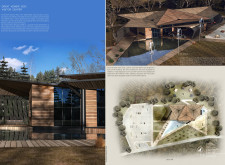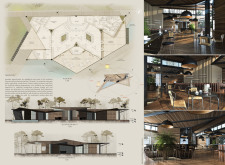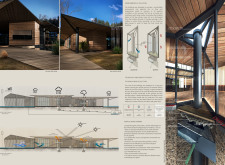5 key facts about this project
The visitor center operates primarily as an educational hub, offering insights into the biodiversity of the bog and encouraging environmental stewardship. It accommodates various functions, including exhibition spaces, a café, children's activity areas, and multipurpose rooms for workshops and community events. The design prioritizes accessibility, allowing visitors to experience various aspects of the park safely and comfortably.
Sustainable Design Strategies
What distinguishes the Great Kemeri Bog Visitor Center from other similar projects is its emphasis on sustainable design principles. The architecture integrates extensive use of local materials, such as wood and steel, which not only minimize environmental impact but also enhance the aesthetic connection to the surrounding landscape. The use of large glass panels facilitates natural lighting and views, breaking down barriers between indoors and outdoors.
Additionally, features such as vertical wind turbines and rainwater harvesting systems reflect an innovative approach to energy efficiency and resource management. By incorporating these technologies, the visitor center aims to operate with minimal ecological footprint while serving as a model for environmental responsibility in architectural design.
Functional Spaces and Site Integration
The layout of the Great Kemeri Bog Visitor Center is meticulously designed to optimize visitor flow and create engaging experiences. The main building is strategically placed to harmonize with the park’s landscape, surrounded by boardwalks connecting various zones, including picnic areas and play spaces. This careful consideration of spatial organization allows visitors to explore the site while enjoying educational installations that promote interaction with nature.
In creating multifunctional spaces, the design team has ensured that the visitor center can easily adapt to seasonal events and the varying needs of the community. Play zones are incorporated to provide recreational opportunities for families, while ample space for gatherings fosters community involvement in environmental education.
For a more in-depth understanding of the architectural design, including architectural plans and sections, readers are encouraged to explore the project presentation for detailed insights into the innovative strategies employed in this visitor center. This exploration will provide clarity on the architectural ideas that contribute to the unique character of the Great Kemeri Bog Visitor Center.


























